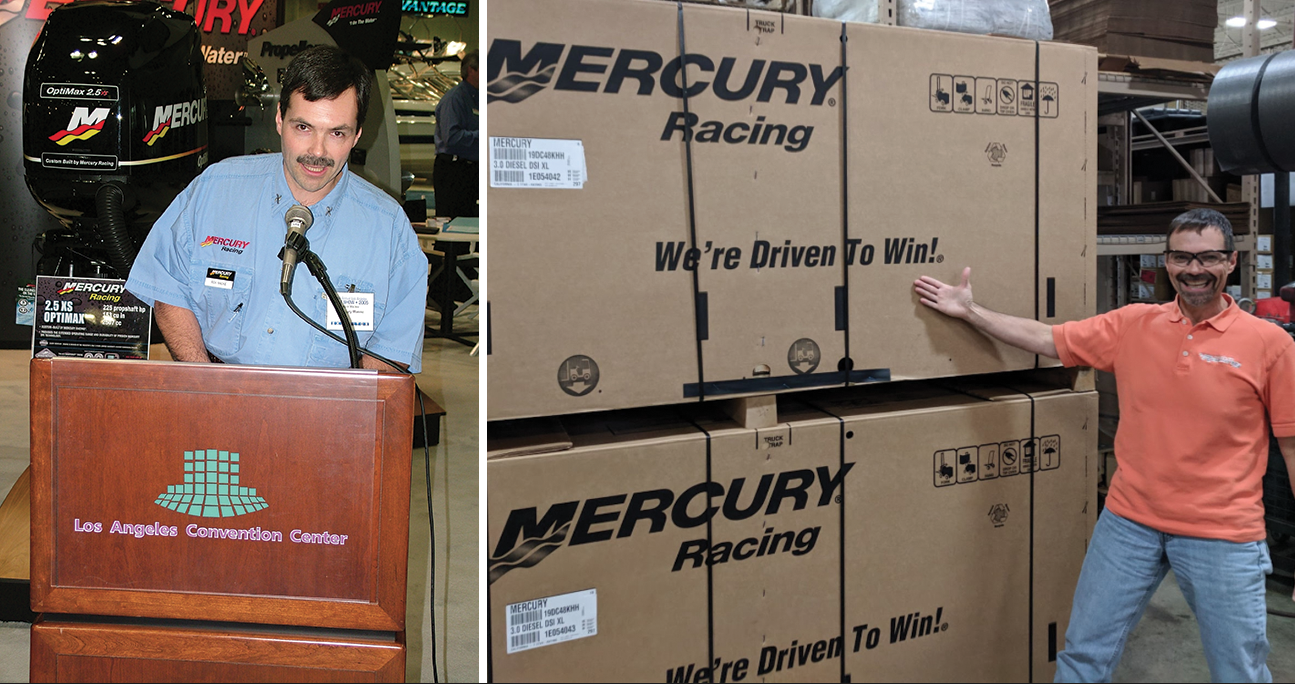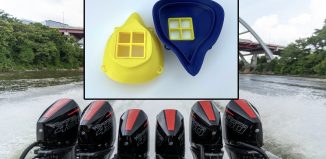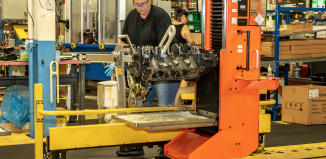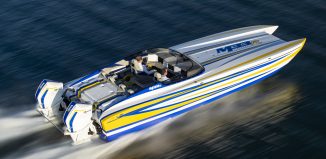Mercury Racing Veteran Rick Mackie to Retire

When any new era begins—like when Mercury Racing unveiled its 400R outboard—it’s like the sound of a door opening.
And when any existing era ends—like when Senior Marketing Manager Rick Mackie retires this month after a 30-year association with Mercury Racing—the sound of a massive door slamming shut will be deafening.
In a career that has encompassed everything from two-seater tunnel boats to the introduction of the new 450R outboard, there’s very little that Mackie hasn’t witnessed in the marine industry. His tenure at Mercury Racing pre-dates even the very name of the company: He joined the staff of Mercury Hi-Performance in 1988, when he was 26 years old.
“I’ve been near the water all of my life, and I’ve always been around Mercury,” Mackie says. “We had Mercury power on our family boats, and my brother was a Mercury tech during the summer. As kids, he and I built race boats together that were always Mercury-powered. It was almost my destiny to work at Mercury, and for 30 years my dream came true.”
A product support specialist focusing on tunnel boat competition, Mackie drove a “box van” (a precursor to today’s high-tech marketing trucks) equipped with Mercury-branded apparel and merchandise to races across the U.S. and Canada. It could also haul a spare powerhead and gear case, along with a two-seater tunnel boat, on which he gave rides to members of the media. (That brush with the media was a turning point for Mackie—one that would have reverberations for decades.) In these early days, Mackie would also experience ride-alongs with some of the sport’s most famous racers, from Bill Seebold and Scott Gillman to Chris Bush and Gregg Foster.
“I got to ride with all these top-notch drivers, because they needed someone in the back,” he recalls. “It was a lot of fun.”
In due course, Mackie became more heavily involved in the marketing and public relations side of Mercury, and in the 1990s was taken under the wing of PR guru Tom Mueller (famous for his experience with Wrangler Jeans). “He got me more into the media side as assistant marketing manager, and I started writing press releases,” he says. One of his first gigs was writing a daily pre-Internet facts blast called Speed Faxes. “I’d write up press releases about tunnel and offshore race results and put it through the fax machine,” he says. “That was my very first experience in media and event writing.”
Mackie’s experience with Mercury gave him an up-close view of how the company’s innovative power products evolved over the years. “One of the big stern-drive milestones for us was the MerCruiser 1000SC (supercharged),” he says. “On the outboard side, when I first started, we had the 2.4 EFIs, and in 1991, that segued into the 2.5 EFIs. That was a really popular motor in the outboard stock class.”
Mackie got used to wearing many hats within the Mercury organization, becoming a “jack of all trades” who mastered the fine arts of public-relations, catalogs, advertising, calendars—anything to do with promoting the company as a spokesman and in print.
On July 20, 1990, Brunswick Corp. (owner of what was then called Mercury Hi-Performance) acquired Kiekhaefer Aeromarine, and the two companies merged. The son of Mercury founder Carl Kiekhaefer, Fred Kiekhaefer had taken the reins of Kiekhaefer Aeromarine in 1983 when Carl passed away; he then took over as president of Mercury Performance Products in 1990. Merging together presented significant challenges for employees in both organizations.
“It was a big adjustment,” Mackie says. “But working with Fred Kiekhaefer was a real learning experience. That was a very interesting era, from 1990 through 2012, when he left. All of the different products that we came out with was incredible.”
Mackie’s extensive work in Mercury’s catalogs helps him think of the products in what he calls “little time capsules,” and he’s able to reference back to them whenever it becomes necessary. He recalls the carbureted 500-hp engine’s release, followed by the HP500EFI in the late 1990s. “That one really stood the test of time, both as a recreational engine and in racing,” he says. In fact, Mackie just returned from a vacation to his hometown in Michigan, where a poker run was taking place, and saw an interesting boat there. “Brian and Wilma Ross were running their Donzi F2-46 race boat, Snap-On Tools, which still has the 500EFIs. It was like something out of a time warp. And it still looks like it came right off the factory showroom.”
After 30 years with Mercury Racing, Mackie has experienced bumper-crop seasons as well as an economic downturn that spelled doom for dozens of boatbuilders. “I guess I could call myself a survivor,” he chuckles. “That terrible recession was one timeframe where I thought, well, this may be the end of the dream ride. But we held on, and I think because our department was so lean and mean, that helped us survive.”
Another of Mackie’s brilliant efforts was to take the initiative to create an architecture for Mercury Racing’s social media environment. “I remember one day thinking, ‘I’m going to start a Facebook page, and I’m going to start a blog and a Twitter account, and a YouTube channel,’ all at once, around the time the Internet was really taking off,” he says. His handiwork led the NMMA to award Mercury with the ‘Best Website’ award. “That was a pretty cool accomplishment,” he says.
But arguably Mackie’s biggest accomplishment online to date has been his incredibly popular and informative Mercury Racing blog, which commands a gigantic readership. Profusely illustrated and cutting edge, this blog has been the quintessential document to keep the industry informed about all of the innovations coming out of Fond du Lac, WI. It’s just one of the many reasons why Mackie is one of the best-known and respected people in the world of high-performance boating.
Powerboat Nation and Speedboat Magazine salute Rick Mackie, who plans to spend some quality time with his young son for the foreseeable future. Thanks for all your accomplishments. Nobody could have done a better job.







